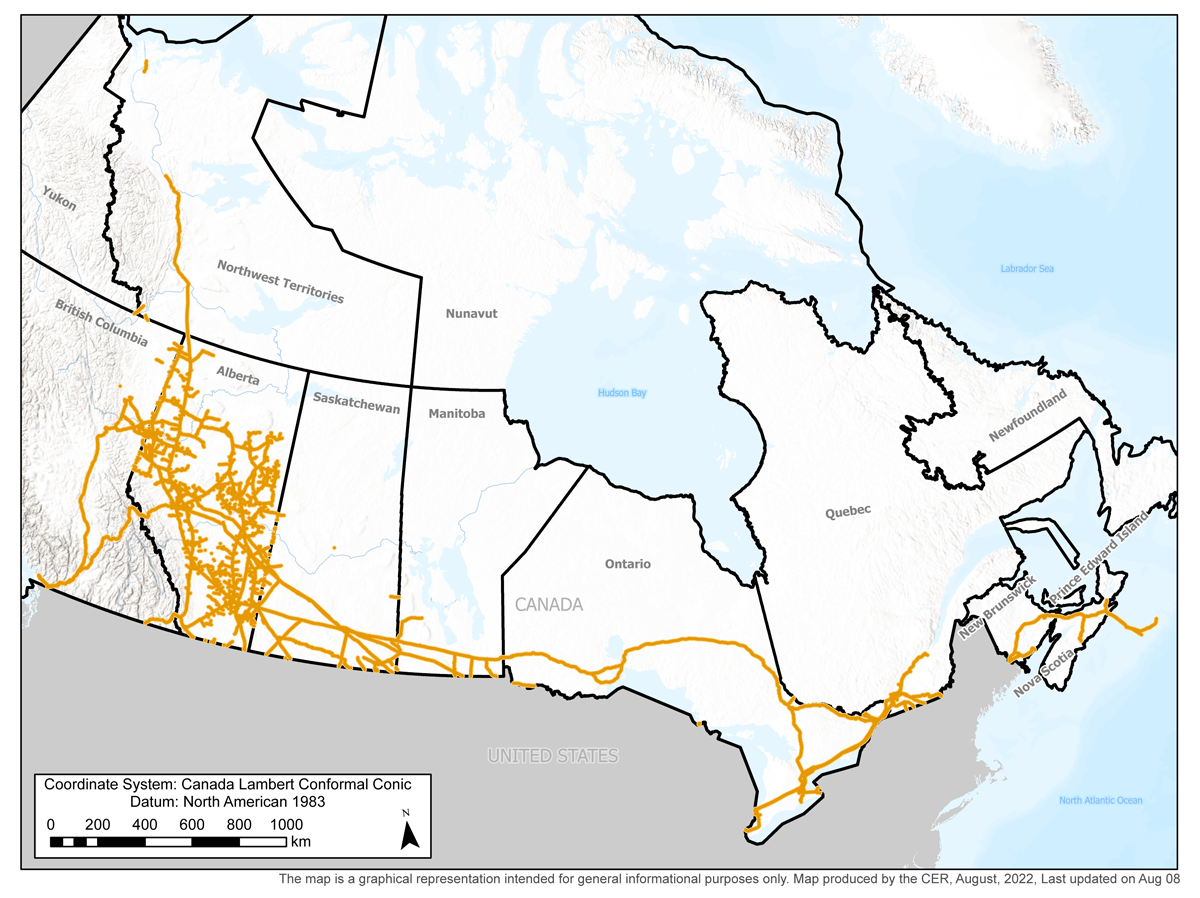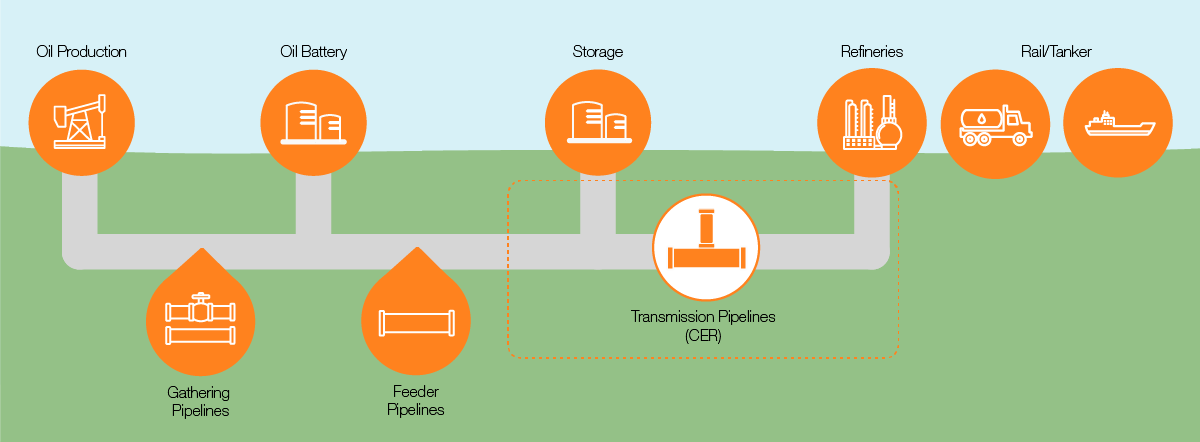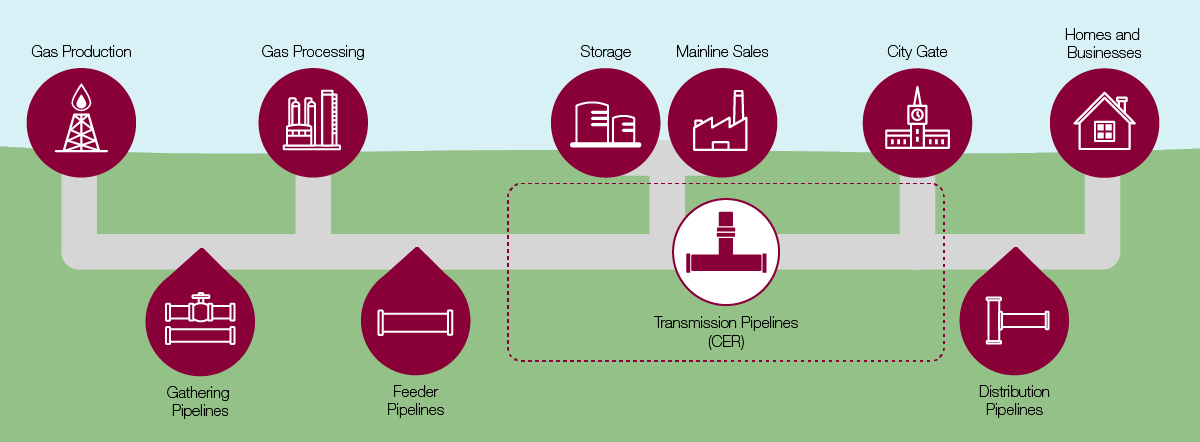Market Snapshot: Canada’s Pipeline System – Who Regulates What?
Connect/Contact Us
Please send comments, questions, or suggestions for Market Snapshot topics to snapshots@cer-rec.gc.ca
Release date: 2022-07-20
Canada’s pipeline system is a network of pipelines regulated by federal, provincial, and territorial regulators. It includes more than 760 000 kilometers (km) of pipelines that transport crude oilDefinition*, natural gasDefinition*, natural gas liquidsDefinition*, and refined petroleum productsDefinition* across the country.Footnote 1Footnote 2 For perspective, you would need to drive from Vancouver, British Columbia to Halifax, Nova Scotia approximately 130 times to cover the same distance!
Figure 1: Map of pipelines regulated by the Canada Energy Regulator (CER)

Source and Description
Source: CER created from GDM data.
Description: This is a map of pipelines regulated by the CER. The CER regulates pipeline systems that cross provincial or international boundaries, among other roles. See the “Who regulates pipelines in Canada?” section below for more details on the CER’s responsibilities.
Pipelines can carry commodities other than oil and gas, such as carbon dioxide, natural gas liquids, slurry, and water. There are more than 760 000 km of pipelines in Canada, of which over 10% or 76 000 km is regulated by the CER.
Pipelines under provincial or territorial jurisdiction are not displayed in this map.
Provincial and territorial regulators of pipelines and energy
Description: This table presents a list of many of the provincial and territorial regulators of pipelines and energy in Canada. Regulators such as public utility boards can regulate utility rates or physical projects. The CER oversees both physical projects, including pipeline construction and operation, as well as financial and economic aspects.
| Jurisdiction | Regulator | Economic Function | Operational Function | Description |
|---|---|---|---|---|
| Yukon | Yukon Department of Energy, Mines and Resources | ✔ | ✔ |
The Department of Energy, Mines and Resources is responsible for regulating the exploration and development of Yukon’s oil and gas resources, including issuing oil and gas rights, administering royalty revenues and licences, and regulating industry activities. In 1993, the Canada Yukon Oil and Gas Accord was signed. It transferred responsibility for oil and gas resources from the NEB to the Government of Yukon. |
| Yukon | Yukon Utilities Board | ✔ |
The Yukon Utilities Board regulates the rates of two electricity providers in the territory, Yukon Energy Corporation and ATCO Electric Yukon. |
|
| Northwest Territories | The Office of the Regulator of Oil and Gas Operations (OROGO) | ✔ |
The OROGO regulates onshore oil and gas operations in the Northwest Territories, outside federal areas and the Inuvialuit Settlement Region. Their responsibilities include application reviews, regulating seismic and drilling operations, pipeline and well regulation, inspection and compliance, and emergency response and investigation. The OROGO was established in 2014 when the Northwest Territories’ Oil and Gas Operations Act came into force. |
|
| Northwest Territories | Northwest Territories Public Utilities Board (NWT PUB) | ✔ |
The NWT PUB is an independent agency of the Government of the Northwest Territories. It is responsible for the regulation of public utilities in the NWT, such as natural gas and electricity. There are currently six utility companies operating in the NWT that are regulated by the PUB. The NWT Power Corporation, Northland Utilities (Yellowknife) Limited, and Northland Utilities (NWT) Limited are fully regulated by the PUB. The remaining three companies are regulated by the PUB on a complaints-basis only. |
|
| Nunavut | Nunavut Utility Rates Review Council (URRC) | ✔ |
The URRC is an arms-length advisory council that assesses rates, policy development, and major project applications submitted by the Qulliq Energy Corporation. The Council also provides recommendations to the Government of Nunavut on power rates. |
|
| British Columbia | British Columbia Oil and Gas Commission (BCOGC) | ✔ |
The BCOGC is responsible for overseeing oil and gas operations, refineries, and geothermal development in British Columbia. It regulates 50 813 km of pipelines, 78% of which carry natural gas. For example, the BCOGC regulates the Coastal GasLink pipeline, the LNG Canada export terminal project, and the Vancouver Airport Fuel Delivery project. The Commission was established in 1998. |
|
| British Columbia | British Columbia Utilities Commission (BCUC) | ✔ |
The BCUC is an independent regulatory agency that regulates energy utilities’ rate applications, and their construction plans for new facilities. The BCUC also regulates the financial side of common carrier pipelines located entirely within B.C., including tolls and the conditions for using the service of pipelines. The BCUC regulates NorthRiver Midstream gas gathering pipelines, BC Hydro and FortisBC Energy Inc. |
|
| Alberta | Alberta Energy Regulator (AER) | ✔ |
The AER regulates energy development in Alberta, including the life cycle of oil, oil sands, natural gas, and coal projects. It regulates 433 000 km of pipelines, 146 000 operating wells, 21 000 gas facilities, and 30 000 oil facilities. The AER regulates the Alberta Products Pipe Line, the Pembina Pipeline System, and the Syncrude Pipeline. The AER was established in 1938. |
|
| Alberta | Alberta Utilities Commission (AUC) | ✔ | ✔ |
The AUC is an independent, quasi-judicial agency of the province of Alberta that regulates the utilities sector, natural gas, and electricity markets. The AUC approves new pipeline construction, issues licences for pipeline construction, operation, abandonment and removal, reviews and approves routing, approves rates to be paid to transport gas through the pipeline system, and establishes rules and regulations for the design, construction, operation and abandonment of gas utility pipelines in Alberta. The AUC regulates ATCO Gas and Pipelines and Apex Utilities Inc. (formerly AltaGas Utilities Inc.), which are both natural gas distributors in Alberta. |
| Saskatchewan | Saskatchewan Ministry of Energy and Resources | ✔ |
The Ministry operates as the primary regulatory authority for the oil and gas industry and ensures competitive royalty systems, regulations, and policies for all natural resource sectors. For example, the Ministry regulates the TransGas pipeline system. |
|
| Saskatchewan | Saskatchewan Rate Review Panel | ✔ |
The Saskatchewan Rate Review Panel advises the Government of Saskatchewan on rate applications proposed by SaskEnergy and SaskPower. The Panel reviews each application to determine the fairness and reasonableness of the rate request, and provides the government with an objective evaluation. |
|
| Manitoba | Manitoba Natural Resources and Northern Development Division | ✔ |
The Natural Resources and Northern Development Division regulates the exploration, development, production and transportation of oil and gas. |
|
| Manitoba | Manitoba Public Utilities Board (PUB) | ✔ | ✔ |
The PUB regulates natural gas, propane, and electricity rates, and monitors the construction and operation of gas pipelines that are subject to provincial jurisdiction. The PUB regulates rates for natural gas supplied by Centra Gas and electricity rates by Manitoba Hydro. |
| Ontario | Ontario Energy Board (OEB) | ✔ | ✔ |
The OEB regulates electricity and natural gas rates. The OEB also reviews applications for new electricity transmission lines and natural gas pipelines. The OEB regulates Ontario’s main natural gas distribution company, Enbridge Gas Inc. The Board was established in 1960. |
| Ontario | Ministry of Northern Development, Mines, Natural Resources and Forestry | ✔ |
The Ministry regulates licenses for the exploration and extraction of oil, natural gas, and salt resources, as well as underground storage. They are also responsible for managing these resources where they occur on Crown lands. |
|
| Quebec | Régie de l’énergie du Québec | ✔ |
The Régie de l'énergie du Québec is the economic regulator of electricity and natural gas rates in Quebec. For example, the Régie de l'énergie regulates Énergir (formerly Gaz Métro) and Enbridge Gazifère, both gas distributors in Quebec, but only in matters of economic viability and tolls and tariffs. |
|
| Quebec | Régie du bâtiment du Québec | ✔ |
The Régie du bâtiment du Québec regulates the installation and exploitation of gas and refined petroleum product pipelines in Quebec. The Régie du bâtiment du Québec regulates the Pipeline Saint-Laurent, which transports refined petroleum products. |
|
| Quebec | Ministère de l’Énergie et des Ressources naturelles | ✔ |
The Ministère de l’Énergie regulates 16 km of crude oil pipelines in Quebec. It provides integrity oversight and performs inspections and audits on the companies it regulates. |
|
| New Brunswick | New Brunswick Energy & Utilities Board (EUB) | ✔ | ✔ |
The EUB regulates various aspects of the electricity and natural gas sectors. The EUB also sets weekly maximum prices for petroleum products sold within the province. The EUB promotes safety and ensures that companies design, construct, operate, and abandon pipelines safely. The EUB regulates Liberty Utilities, which distributes natural gas throughput southern New Brunswick. The Board was established in 1910. |
| Nova Scotia | Nova Scotia Utility & Review Board (NSUARB) | ✔ | ✔ |
The NSUARB sets petroleum product prices and sets rates for electricity, water, and natural gas utilities. In 1999, the Board assumed responsibility for the regulation of oil and gas pipeline construction, operations, and maintenance. NSUARB regulates Nova Scotia Power, which is responsible for electricity distribution in the province. The Board was established in 1992. |
| Newfoundland and Labrador | Newfoundland and Labrador Board of Commissioners of Public Utilities | ✔ |
The Board is responsible for the regulation of electricity rates in the province. In 2004, the Board assumed responsibility for regulation of maximum prices for petroleum products in the province. |
|
| Prince Edward Island | Prince Edward Island Regulatory & Appeals Commission | ✔ |
The Commission was established in 1991 and is responsible for regulating petroleum pricing, as well as electricity and water utilities. It regulates the operations of Maritime Electric Company Limited. |
|
| Newfoundland and Labrador Offshore | Canada Newfoundland and Labrador Offshore Petroleum Board (C-NLOPB) | ✔ |
The role of the C-NLOPB is to facilitate the exploration for and development of petroleum resources in the Canada-Newfoundland and Labrador Offshore Area. On 5 April 2022, NRCan announced that the Board’s mandate would be expanded to include the regulation of offshore renewable energy development, such as wind and clean hydrogen. The Board will be renamed to the Canada-Newfoundland and Labrador Offshore Energy Board (C-NLOEB) to reflect its new mandate. There are currently four production facilities in offshore Newfoundland and Labrador: Hebron, Hibernia, Terra Nova and White Rose. |
|
| Nova Scotia offshore | Canada Nova Scotia Offshore Petroleum Board (CNSOPB) | ✔ |
Since 1990, the CNSOPB has been overseeing all activities through the lifecycle of offshore oil and gas projects in the Canada-Nova Scotia offshore area, from exploration through development, and finally to abandonment. The CNSOPB regulates the Sable Offshore Energy Project and the Deep Panuke Offshore Gas Development Project, which are both now permanently decommissioned and abandoned. |
Who regulates pipelines in Canada?
Pipeline transportation is highly regulated. Regulators such as public utility boards can regulate utility rates or physical projects. The CER oversees both physical projects, including pipeline construction and operation, as well as financial and economic aspects.Footnote 3Footnote 4
The federal regulator
Pipelines that cross provincial, territorial, or international boundaries are regulated federally by the CER, primarily through the Canadian Energy Regulator Act. As of 2021, the CER is responsible for over 76 000 km of pipeline,Footnote 5 which is about 10% of the Canadian total. The majority of these are transmission pipelines.
The CER is a lifecycle regulator and monitors a project through the phases of pipeline application, construction, operation, decommissioning, and abandonment. The CER also has a mandate for financial and economic regulation, by regulating tolls and tariffs, and overseeing abandonment funding and financial resources. Visit the Pipeline Profiles for details on major CER-regulated pipelines.
Provincial regulators
Pipelines that are located entirely within one province are regulated by the relevant provincial regulator. They typically regulate gathering, feeder, and distribution pipelines, as well as other energy-related activities such as exploration, petroleum product prices, and other utilities. See the table above for the list of provincial and territorial regulators and their roles.
Establishing jurisdictional authority
There are times when regulators must determine under which jurisdiction (provincial or federal) a pipeline or project will fall. In those instances, the regulator will consider jurisdiction by applying the relevant legal test.
Examples of this include the TransCanada Alberta System [Folder 549124], the sale of Westcoast Gathering System assets [Folder 3817720], the Prince Rupert Gas Transmission Project [Folder 3335429], the Coastal GasLink Pipeline Project [Folder 3809973], and the Enbridge Frontier Project [Folder 3962346].
Pipeline regulation in Canada’s North
There are a few active pipelines regulated by the CER in the Northwest Territories (NWT), including the Enbridge Norman Wells Pipeline and the Ikhil pipeline.Footnote 6 Currently, there are no active pipelines in Nunavut or the Arctic Offshore.
Other regulatory responsibilities of the CER in the North includes oil and gas exploration in the onshore Inuvialuit Settlement Region (ISR),Footnote 7 under the NWT’s Oil and Gas Operations Act. Exploration and development in Nunavut, the Canadian Arctic offshore, and the Norman Wells Proven Area (NWT) is regulated under the Canada Oil and Gas Operations Act.Footnote 8
Types of pipelines
A pipeline system is made up of four different types of pipelines. Gathering, feeder, and distribution pipelines are typically regulated by the provincial regulators. Transmission pipelines are typically regulated by the CER.
- Gathering pipelines are mid-sized pipes that deliver products from wells to storage or processing facilities.
- Feeder pipelines move products from storage or processing facilities to transmission pipelines.
- Transmission pipelines are large diameter pipes that deliver products over long distances, usually from storage facilities to end markets.
- Distribution pipelines are used by local distribution companies to deliver natural gas to homes and businesses.
Figure 2: Crude oil and natural gas pipeline system overview
Crude Oil Pipeline System

Natural Gas Pipeline System

Source and Description
Source: CER
Description: This figure shows the movement of crude oil and natural gas though the pipeline system. Transmission pipelines, emphasized in the figure, are typically regulated by the CER. The dotted line indicates the streams served by the transmission pipelines. Gathering, feeder, and distribution pipelines are typically regulated by the provincial regulator.Footnote 9
- Date modified:
